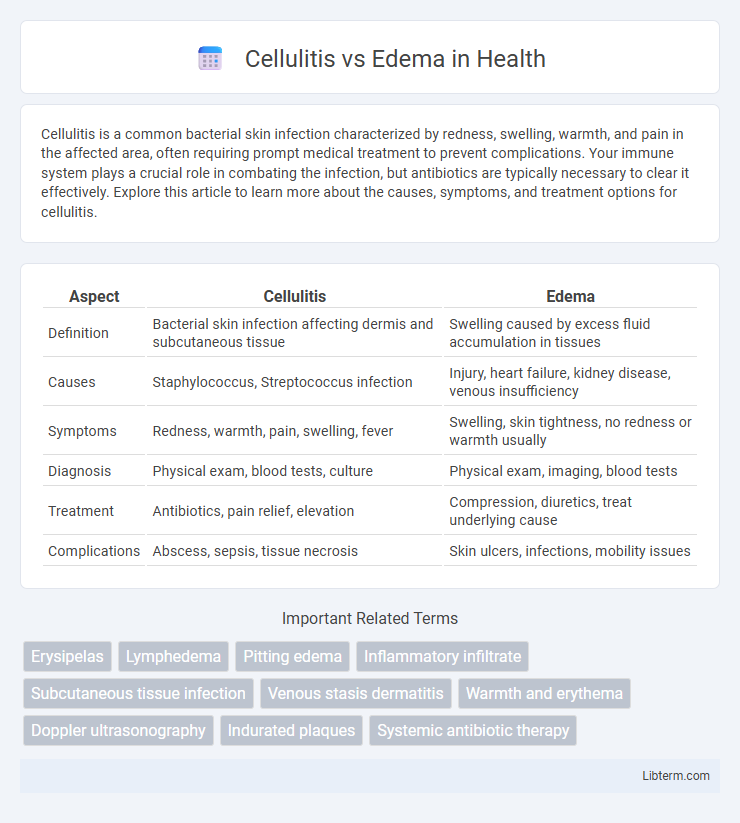Cellulitis is a common bacterial skin infection characterized by redness, swelling, warmth, and pain in the affected area, often requiring prompt medical treatment to prevent complications. Your immune system plays a crucial role in combating the infection, but antibiotics are typically necessary to clear it effectively. Explore this article to learn more about the causes, symptoms, and treatment options for cellulitis.
Table of Comparison
| Aspect | Cellulitis | Edema |
|---|---|---|
| Definition | Bacterial skin infection affecting dermis and subcutaneous tissue | Swelling caused by excess fluid accumulation in tissues |
| Causes | Staphylococcus, Streptococcus infection | Injury, heart failure, kidney disease, venous insufficiency |
| Symptoms | Redness, warmth, pain, swelling, fever | Swelling, skin tightness, no redness or warmth usually |
| Diagnosis | Physical exam, blood tests, culture | Physical exam, imaging, blood tests |
| Treatment | Antibiotics, pain relief, elevation | Compression, diuretics, treat underlying cause |
| Complications | Abscess, sepsis, tissue necrosis | Skin ulcers, infections, mobility issues |
Understanding Cellulitis: Causes and Risk Factors
Cellulitis is a bacterial skin infection primarily caused by Streptococcus and Staphylococcus bacteria, often entering through breaks in the skin such as cuts, insect bites, or surgical wounds. Risk factors for cellulitis include weakened immune systems, diabetes, obesity, chronic swelling (lymphedema), and skin conditions like eczema or athlete's foot that compromise the skin barrier. Recognizing these causes and vulnerabilities is crucial for differentiating cellulitis from edema, which is swelling caused by fluid accumulation rather than infection.
What is Edema? Definition and Underlying Mechanisms
Edema is the abnormal accumulation of fluid in the interstitial spaces or body cavities, leading to swelling. It occurs due to an imbalance in hydrostatic pressure, oncotic pressure, lymphatic drainage, or increased capillary permeability. Common causes include inflammation, venous insufficiency, heart failure, or kidney disease, which disrupt normal fluid homeostasis and lead to fluid retention.
Key Differences Between Cellulitis and Edema
Cellulitis is a bacterial skin infection characterized by redness, swelling, warmth, and pain, often accompanied by fever and systemic symptoms, whereas edema is the accumulation of fluid in tissues causing swelling without infection or inflammation signs. Cellulitis typically requires antibiotic treatment, while edema treatment focuses on addressing underlying causes such as heart failure, venous insufficiency, or kidney disease. Diagnostic differentiation relies on clinical presentation, presence of systemic symptoms, and sometimes laboratory tests or imaging to exclude infections in swollen limbs.
Common Symptoms: How to Identify Each Condition
Cellulitis typically presents with localized redness, warmth, swelling, and pain, often accompanied by fever and chills, indicating an infection of the skin and underlying tissues. Edema is characterized by generalized or localized swelling due to fluid accumulation, usually without redness or significant pain unless severe, and is often associated with underlying conditions like heart failure or kidney disease. Identifying cellulitis involves noting the sudden onset of erythema and tenderness, whereas edema is recognized by pitting or non-pitting swelling that develops gradually.
Diagnostic Approaches: Distinguishing Cellulitis from Edema
Differentiating cellulitis from edema involves a combination of clinical examination and diagnostic tools such as ultrasound and blood tests. Cellulitis typically presents with localized erythema, warmth, swelling, and tenderness, often accompanied by systemic signs like fever and elevated white blood cell count, whereas edema is characterized by diffuse swelling without skin redness or warmth. Imaging studies and laboratory results help confirm cellulitis by identifying underlying infection, preventing misdiagnosis and ensuring appropriate antibiotic treatment.
Treatment Options for Cellulitis
Treatment options for cellulitis primarily include a prescribed course of oral or intravenous antibiotics targeting common causative bacteria such as Streptococcus and Staphylococcus species. Hospitalization may be required for severe cases to administer intravenous antibiotics and monitor for complications. Supportive measures like elevation of the affected limb and analgesics can aid in reducing inflammation and pain during recovery.
Management Strategies for Edema
Management strategies for edema emphasize compression therapy, which includes the use of graduated compression stockings or bandages to improve venous return and reduce fluid accumulation. Elevation of the affected limb above heart level is crucial to facilitate lymphatic drainage and minimize swelling. Diuretics may be prescribed in specific cases to aid fluid removal, while addressing underlying causes such as heart failure or venous insufficiency is essential for long-term edema control.
Complications: When to Seek Medical Attention
Complications of cellulitis include rapidly spreading infection, abscess formation, and systemic involvement such as sepsis, requiring prompt medical attention. Edema, while often benign, can lead to skin ulceration, infection, or chronic swelling necessitating evaluation to prevent worsening outcomes. Seek immediate care if symptoms worsen, pain increases, fever develops, or the affected area shows signs of spreading redness or warmth.
Preventive Measures for Cellulitis and Edema
Preventive measures for cellulitis include maintaining good skin hygiene, promptly treating cuts or wounds, and managing chronic conditions like diabetes to reduce infection risk. For edema, preventive strategies involve regular physical activity, elevating affected limbs, reducing salt intake, and wearing compression garments to improve circulation. Both conditions benefit from early detection and consistent care to avoid complications and promote overall skin and vascular health.
Frequently Asked Questions on Cellulitis vs Edema
Cellulitis is a bacterial skin infection characterized by redness, warmth, swelling, and pain, often requiring antibiotics, while edema is the accumulation of fluid causing swelling without infection. Frequently asked questions about cellulitis vs edema often focus on distinguishing symptoms, treatment options, and when to seek medical attention. Understanding that cellulitis usually presents with systemic signs like fever, while edema results mainly from fluid retention due to various causes such as heart failure or injury, helps in accurate diagnosis and timely management.
Cellulitis Infographic

 libterm.com
libterm.com